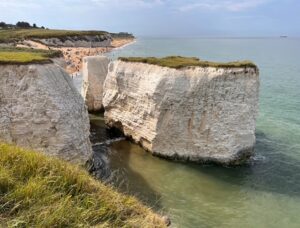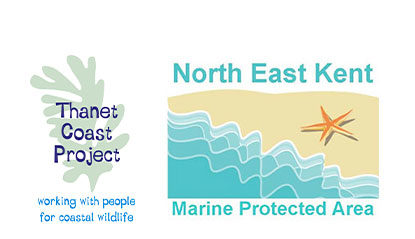Nature designations
The NEKMPA (Thanet Coast) consists of many nature conservation designations:
- Two Special Areas of Conservation (Thanet Coast SAC & Sandwich Bay SAC)
- A Special Protection Area (Thanet Coast & Sandwich Bay SPA)
- A Wetland of International Importance (Thanet Coast & Sandwich Bay Ramsar site)
- Site of Special Scientific Interest (all Thanet Coast SSSI – see below, and part of the Sandwich Bay to Hacklinge Marshes SSSI)
- Kent’s largest National Nature Reserve – the ‘Sandwich and Pegwell Bay NNR‘
- A Marine Conservation Zone (Thanet Coast MCZ)
- Glossary for site definitions
In 2013, the Thanet Coast MCZ (Marine Conservation Zone) was added, as part of progress towards a network of marine protected areas (Marine and Coastal Access Act 2009) – and all the designations are now collectively known as the “North East Kent Marine Protected Area” (NEKMPA). (Note: Previously the international designations were collectively known as the ‘North East Kent European marine site’).
The NEKMPA is legally protected and the shore and sea has a management scheme which ensures that they are managed in a way that conserves their importance for wildlife. The citations for these designations (SAC; SPA and SSSIs) can be found in the Appendices of the Management Scheme 2001-6. This scheme’s actions are reviewed and updated every 6 years.
The Habitats and Wild Birds Directives – What happened in 2021:
DEFRA Statement (following the UK’s exit from the EU, 1 January 2021): The legislation transposing the EU Habitats Directive and the Wild Birds Directive has been changed so that they continue to operate effectively from 1 January 2021. This includes the Conservation of Habitats and Species Regulations 2017 (as amended) in England and Wales, and the Conservation of Offshore Marine Habitats and Species Regulations 2017 (as amended). The changes have been made by the Conservation of Habitats and Species (Amendment) (EU Exit) Regulations 2019.
The changes ensure the strict protections afforded to sites, habitats and species, including wild birds, continue. Further information about the changes introduced by the amending regulations is available here. Most of these changes involved transferring functions from the European Commission to the appropriate authorities in England and Wales. All other processes or terms in the 2017 Regulations remain unchanged and existing guidance is still relevant.
Thanet Coast Site of Special Scientific Interest (Thanet Coast SSSI)
Most of the Thanet Coast is designated as a Site of Special Scientific Interest (which is all above Mean Low Water) and the foreshore landowner has specific responsibilities and works to an agreement with Natural England on the management of the coastline for wildlife and habitats of the coast covered by the SSSI designation.
Thanet Council is the main landowner & manager of the Thanet Coast SSSI and works to a Thanet Coast SSSI Site Management Statement (last reviewed May 2010). This statement allows the authority to undertake the general works stated, but anything else (new projects or work) requires specific Natural England’s assent
Why is it important?
Chalk talk
- Thanet is the eastern-most outcrop of chalk in Britain and one of the eastern-most in Europe
- Thanet contains some of the best chalk caves in Britain and chalk reefs in the south-east
- The Thanet Coast has the longest continuous stretch of coastal chalk in Britain
- It represents 20% of UK – & 12% of European – coastal chalk
- The chalk cliff and cave habitats and species are very uncommon in Europe and therefore internationally important.
Bird facts
- The intertidal reef, together with the mudflats and sandflats, provide valuable feeding grounds for wintering birds, which roost on shingle and sand above the high water mark. Of these, the Turnstone and Golden Plover occur here in internationally important numbers.
- In summer, shingle use to provide an important breeding site for Little Terns.
- Wintering Golden Plover roost on mudflats in Pegwell Bay


